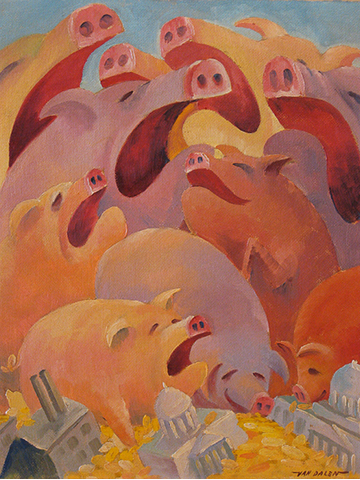Originally published January 24, 2017 at 7:00 am Michael Upchurch,
Cascadia Art Museum’s “Northwest Social Realism and the American Scene: 1930-1950” is a good starting point for examining the leftist fervor of the Pacific Northwest arts scene in the mid-20th century.
Pieter van Dalen’s “Statesmanship,” in Cascadia Art Museum’s “Northwest Social Realism and the American Scene: 1930-1950,” speaks to us with startling timeliness as our new president looks to pack his Cabinet with candidates who have billions in wealth among them.
It’s an oil on canvas-board, painted circa 1930, that shows nine pigs looming over a landscape of factories and government buildings swimming in gold coins. Clearly they can’t wait to swill the whole business down.
“Statesmanship” isn’t the finest piece in this eye-opening group exhibition curated by Seattle’s David Martin, a longtime explorer of the hidden corners of Pacific Northwest art history. But it’s a good starting point for examining the leftist fervor that dominated our arts scene in the mid-20th century.
The show includes paintings, photographs and prints by artists Martin has championed in the past. Tacoma photographer Virna Haffer is represented with two powerful black-and-white shots of Seattle’s Hooverville taken at the height of the Great Depression. In one of them, a solemn man stands next to piles of newspapers as if their headlines are about to swamp him. In another, a man sorts through trash while Seattle’s handsome Smith Tower looms in the distance.
Abe Blashko’s prints and drawings are a highlight of the show. In “The Pillars,” a 1939 lithograph, a fat-cat couple heads off for a night on the town. Blashko’s fine, stylized portrait of them practically oozes class resentment and derision. His litho-crayon-on-paper from the same year, “Strike Breakers,” comes with a telling footnote. It has a large brown stain on it, courtesy of an angry scab who spat tobacco juice at it. Clearly feelings were running as high back then as they are now.
Richard Bennett’s beautiful tempera paintings from the 1940s — “Clearing Land,” “Loggers,” “Splitting Shakes” — are, by contrast, quietly heroic. The way he arrays his laboring figures against their shadowy forest landscapes has the intricacy of a fugue.
Richard Correll’s linocuts from the late 1930s and early 1940s do something similar. His bold way with line and form brings “Cityscape,” “Air Raid Wardens” and “Athletes” to animated life. He sounds a sorrowful note in “The Last Fall,” in which two boxers console each other after a loss. “Man Running,” Correll’s most daring piece, pushes the abstract potential of the title’s fleeing figure to its outer limits.
Women and minorities figure prominently in the show. Yvonne Twining Humber demonstrates a keen eye for urban sights in “Closing Circus” and “City View.” Helmi Juvonen’s Hooverville sketches and paintings of Native American life reveal her as more than just the troubled eccentric she’s reputed to be. There’s a dandy Z. Vanessa Helder watercolor, “Fall on Brown’s Mountain,” in which, thanks to her wizardry in the medium, she pulls off sharp detail, shading and shaping worthy of Thomas Hart Benton.
Kamekichi Tokita is represented by hilly Seattle city scenes and a self-portrait from the mid-1930s that’s both defiant and alluring. Another self-portrait by Milt Simons, the first African-American art instructor in Seattle, is so unusually subdued in tone — the artist’s head bowed down, his eyes gently closed — that it leaves you deeply curious about his other work.
More than a dozen other artists — including future “Northwest Mystics” Guy Anderson and Kenneth Callahan, working in figurative mode — are included in the show. This survey casts its net wide and pulls in unexpected treasures.
Michael Upchurch: www.michaelupchurchauthor.com
EXHIBITION REVIEW
‘Northwest Social Realism and the American Scene: 1930-1950’
11 a.m.-6 p.m. Wednesdays-Sundays through March 26. Cascadia Art Museum, 190 Sunset Ave., #E, Edmonds; $7-$10 (425-336-4809 or cascadiaartmuseum.org).
Original article: Edmonds museum exhibit shows how artists responded to hard times


